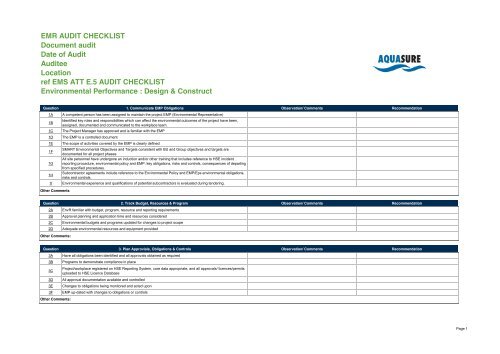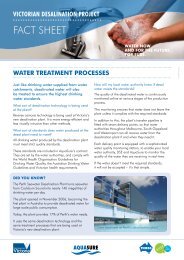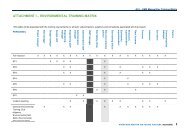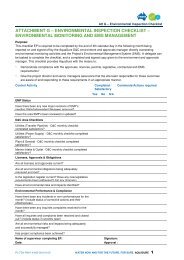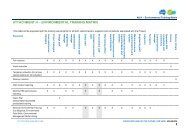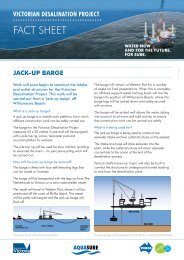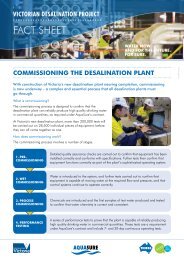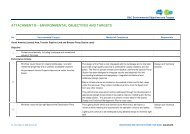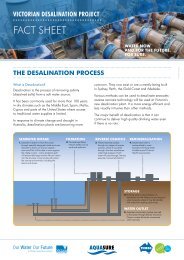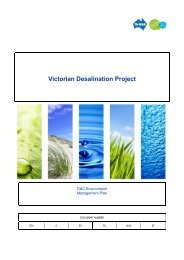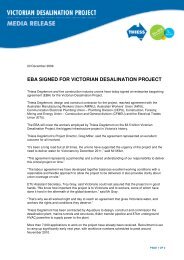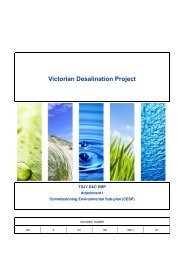Environmental Audit Checklist - Aquasure
Environmental Audit Checklist - Aquasure
Environmental Audit Checklist - Aquasure
You also want an ePaper? Increase the reach of your titles
YUMPU automatically turns print PDFs into web optimized ePapers that Google loves.
Att E EMS Manual <strong>Audit</strong> ProcedureTABLE OF CONTENTS1. . SCHEDULE THE AUDIT .............................................................................................................................. 31.1 Systems and area implementation audits 31.2 External audits including certification 32. . PLAN THE AUDIT ........................................................................................................................................ 43. . CONDUCT THE AUDIT ................................................................................................................................ 54. . DEVELOP AUDIT REPORT AND ACTION PLAN ...................................................................................... 64.1 Prepare and distribute draft audit report 64.2 Distribute final audit report 65. . AUDIT FOLLOW-UP .................................................................................................................................... 7
Att E EMS Manual <strong>Audit</strong> ProcedureProcedure and information<strong>Environmental</strong> audits are an independent examination of how processes are being or have been performed toensure compliance with environmental requirements is being met. <strong>Audit</strong>s also provide data which can be used todevelop preventative or corrective actions for identified risks.<strong>Audit</strong>ing is one of the requirements of the following standards:~ ISO 14001:2004 clause 4.5.5.This procedure includes internal audits and auditing by external parties.Procedure1. Schedule the audit1.1 Systems and area implementation audits<strong>Environmental</strong> audits of the Contractor are required for the following:~ AquaSure <strong>Environmental</strong> Management System. (AquaSure audits of the EMS Manual will be managed in -SYS-PR002.)~ D&C/O&M environmental management plans~ Area D&C/O&M environmental management plans, including sub plansInformationFor specific requirements refer to <strong>Environmental</strong> audit types in Attachment E.1 in the EMS ManualThe environmental manager must:~ Schedule audits to occur at an appropriate risk-based frequency based on discussion with relevantGovernment Agencies or as determined by specific project requirements~ Coordinate audit schedules to minimise disruption to project operation~ Record the relevant <strong>Audit</strong> Schedule in each respective EMP using the template provided in the EMS Manual.Information<strong>Environmental</strong> audit scheduling in Attachment M2 in EMS Manual.Consult relevant Government Agencies and Project <strong>Environmental</strong> and Systems Managers when setting auditfrequencies.For example, consider having combined audits between H&S, <strong>Environmental</strong> and Management Systems.1.2 External audits including certificationAquaSure and its workplaces will be subject to Certification <strong>Audit</strong>s.Information~ Certification audits are conducted by 3rd party auditors~ Generally, environment and systems managers will schedule Certification audits in liaison with functional andproject managers~ Consultants, suppliers and subcontractors may be audited on a risk based frequency if their performance canaffect the delivery and outcomes of a specific activity/area.
Att E EMS Manual <strong>Audit</strong> ProcedureInformationNot all subcontractors and suppliers need to be audited, eg a stationery supplier.2. Plan the auditThe AquaSure <strong>Environmental</strong> Management Representative (EMR) must:~ Establish and document the following:Purpose and scope of auditArea/Contractor to be auditedContact names within that area/Contractor~ Appoint and notify a suitably qualified lead auditor and/or audit members, if required. The EMR may appointthemself as Lead <strong>Audit</strong>or.InformationRefer <strong>Audit</strong>or Competencies Attachment E.3 of the EMS Manual.<strong>Environmental</strong> <strong>Audit</strong>ors must be assessed and registered by the EMR. Submit assessment information using<strong>Environmental</strong> auditor registration application in Attachment E.4 in EMS Manual.The Lead <strong>Audit</strong>or must:~ Notify the relevant project/area/organisation before the planned audit date of the audit scope~ Before an audit is carried out, check that <strong>Environmental</strong> Management Plans meet:The specific operational requirementsApplicable legislationCertification standardsAquaSure requirements.Information~ <strong>Audit</strong> scoring methods must be discussed to ensure consistency~ Certification Standards include: ISO 14001:2004~ Advise relevant managers if, after auditors conduct an initial desktop audit, management plans and sub-plansneed updating.Information<strong>Audit</strong>ors should consider conducting a desktop audit as a preliminary step in advance of the audit:~ With the audit team, make the necessary preparations to ensure the desired outcomes of the audit can be achieved.Information~ Preparations must cover logistics such as transport, accommodation, tools and PPE required. For example,consider the following details for auditors:Appropriate equipment to comply with site requirements, such as safety boots and long-sleeved shirtsSite-familiarisation tours, if necessary
Att E EMS Manual <strong>Audit</strong> ProcedurePermits or escorts to visit restricted areas on site, such as confined spaces~ Ensure audits focus on the <strong>Environmental</strong> Management System, including:AquaSure and State requirements are satisfiedMeeting ISO requirementsBeing implemented and maintained effectively across operations~ The EMR will audit against a defined set of criteria, e.g. a sub plan. The EMR may decide to maintain and usean environmental audit checklist.InformationA sample environmental audit checklist is found in Attachment E.5 in the EMS Manual. An accompanying helpGuide is attached as Attachment L.6.3. Conduct the auditThe <strong>Audit</strong> Team must:~ Take part in an entry audit meeting with relevant personnel to discuss the following:Scope of auditProposed audit agendaProject personnel to be contacted or interviewed<strong>Audit</strong> objectivesA tentative time for the exit meeting.Information~ Invite senior team members to the entry and exit meeting~ <strong>Audit</strong> activities must focus on verifying the <strong>Environmental</strong> Management Plan implementation as well ascompliance to standards. These are performed by:Interviewing appropriate personnelExamining systems documents and records for evidence of compliance (including forms, photographs,etc)Observing activities~ Carry out a site familiarisation tour before commencing the audit if deemed necessary~ Carry out the audit, formally recording:Specific details of compliance or non-compliance with checklist itemsObjective evidence and any observed non-compliance(s) or discrepancies with system procedures orplanned arrangementsComments and feedback from personnel being interviewed.Information~ Record details as notes for inclusion in the audit report or directly onto the audit checklist or formatted proforma,as applicable~ During the audit, any urgent issues must be immediately reported to the Contractor, in accordance with with-SYS-PR003. Where an
Att E EMS Manual <strong>Audit</strong> Procedureauditor identifies a non-conformance or hazardous situation on site, this shall be promptly notified to theContractor in accordance with this procedure.InformationUrgent issues can include, but are not limited to:~ A potential/actual major environmental catastrophe~ Major actual/potential legal issue~ Assess the most appropriate method to address any audit findings and non-compliance~ Take part in an exit audit meeting with relevant personnel, where all issues raised during the audit will bespecifically addressed and acknowledged by the responsible personnel.InformationAt the exit meeting:~ All findings are summarised and addressed~ The pro-forma <strong>Audit</strong> result including draft of any Non Compliance (NC), Stop Work Order (SWO) or Area forImprovement (AI), Observation (O) or Comment (C) may be handed over to the Contractor during the exitmeeting4. Develop audit report and action plan4.1 Prepare and distribute draft audit reportThe <strong>Audit</strong> Team must:~ Prepare a report based on the objective evidence collected during the audit.InformationCorrective actions must focus on long-term solutions that will prevent recurrence.Capture best practice by including positive reinforcement of good practices in the report:~ Within 2 days of completing the audit, forward the audit report to the Contractor4.2 Distribute final audit reportDistribute the final audit report to:~ <strong>Audit</strong>or~ Contractor~ Other relevant personnel~ Independent Reviewer & <strong>Environmental</strong> <strong>Audit</strong>or~ The State.InformationOther relevant personnel may include:~ Chief Operations Officer~ Quality Manager~ Community and Public Relations Manager.
Att E EMS Manual <strong>Audit</strong> ProcedureEnsure a copy of the audit report is filed in the AquaSure records.5. <strong>Audit</strong> follow-upThe EMR will follow up close out of any NC, SWO or AFI by the Contractor. This may be done separately or at thenext relevant audit, depending on the significance of the finding.
ATTACHMENT E.1 ENVIRONMENTAL AUDIT TYPESAtt E.1 EMS Manual <strong>Environmental</strong> audit typesAquaSure recognises four generic types of environmental audits which can be employed within its operations:1. EMS reviewIt is envisaged that the <strong>Environmental</strong> Management Representative (EMR) will conduct EMS reviews to reviewThis schedule is finalised through discussion with the relevant Government Agencies. The schedule is maintainedby the AquaSure EMR.These Reviews provide assurance, support and direction for AquaSure to ensure EMS obligations are beingachieved and certification to ISO14001 is continued.2. Project/Area EMP implementation auditsIt is envisaged that the <strong>Environmental</strong> Manager will organise these audits with each work area in liaison withproject teams on a risk-based frequency. This schedule is finalised through discussion with the relevantGovernment Agencies.An approved Lead <strong>Audit</strong>or conducts Project/Area System <strong>Audit</strong>s, with the assistance of other auditors ifnecessary. The auditor must be independent of the area being audited.This type of audit includes a review of all, or a selection of, EMS requirements, including compliance with legal andother obligations.An environmental audit checklist (for internal audit) has been developed to measure audit performance refer toAttachment E.5 of the AquaSure EMS Manual.3. Project/workplace compliance auditsThe Environment Manager can organise these audits with each work area in liaison with project teams on a riskbasedfrequency. This schedule is finalised through discussion with the relevant Government Agencies.These audits demonstrate project/area compliance with all, or a selection of, legal obligations, ie conditions oflicenses, permits, approvals and legislation. The auditor must be independent of the area being audited.The scope of compliance audits may be expanded to include contractual or other parent company obligations.The environmental audit checklist referred to above (for internal audit) can be used to record and report results ofthe audit refer to Attachment E.5 of the AquaSure EMS Manual.4. <strong>Audit</strong>s by external partiesManagement processes may be queried, inspected, or audited from time-to-time by:~ Standard certification bodies~ Regulatory authorities such as DSE following an incident~ Finance providers and insurers or parent company partners.The <strong>Environmental</strong> Manager should be notified or involved in all other types of environmental audits by externalparties.5. <strong>Audit</strong> reports and non-conformanceA copy of the audit report will be provided to the auditee. The audit report will include any relevant nonconformances.The auditor may provide a draft audit report before providing the final report.WATER NOW AND FOR THE FUTURE. FOR SURE. AQUASURE. 1
EMS Manual App 12.1_<strong>Environmental</strong> audit types<strong>Audit</strong>s will be reported and any non-conformances will be managed in accordance with Section 9.5 (<strong>Audit</strong>s) andSection 9.3 (Non-conformity, corrective and preventative actions) of the EMS Manual.The auditor, or nominee, will follow up the close-out of any non-conformances.WATER NOW AND FOR THE FUTURE. FOR SURE. AQUASURE. 2
Att E.2 EMS Manual <strong>Environmental</strong> audit and schedulingATTACHMENT E.2 ENVIRONMENTAL AUDIT SCHEDULINGThe required environmental audit frequency for a workplace will be determined, prior to project start up, indiscussion with relevant government agencies. However the following schedule will be proposed:All workplaces are to be audited at key points in the project cycle, as shown in Table 1 below:Table 1 EMS audit schedule guideline<strong>Audit</strong> type Scope of audit Frequency ResponsibilityEstablishment audit(system andcompliance)EMS performance and certification(including EMPs) and<strong>Environmental</strong> approvalcomplianceWithin 3 months ofconstructioncommencement.Environment andApprovals managerCompliance auditTo assess performance in relationto operation of EMS;implementation of EMS and eachother environmental requirement inaccordance with the Project DeedMonthly - During D&CPhaseQuarterly During O&MPhaseAn audit will be conductedwithin 10 days of receipt ofthe Certificate confirmingactivities have beenundertaken in accordancewith the EMP andenvironmentalrequirements. ThisCertificate must besubmitted on the firstbusiness day of eachcalendar month. The auditis to be conducted within10 business days of thatreceipt.IndependentReviewer &<strong>Environmental</strong><strong>Audit</strong>orSee Clause 13.9 of theProject DeedCompliance auditTo assess performance in relationto operation of EMS;implementation of EMS and eachother environmental requirement inaccordance with the Project DeedIf requested by the projectteam in additional tomonitoring listed aboveIndependentReviewer &<strong>Environmental</strong><strong>Audit</strong>orInternal (systemcompliance)EMS performance (includingEMPs) and <strong>Environmental</strong> approvalcompliance3 monthly, and4-12 weeks prior tocompletionEnvironment andApprovals managerISO 140001 externalaudit (system andcompliance)EMS performance and ISO 140001certification (including EMPs) and<strong>Environmental</strong> approvalInitial audit within 6months of start up and asrequired to achieve andmaintain certificationExternalrepresentative ie SAIglobalCompliance DSE EMS compliance As required/requested DSE representativeInspection checklists Current activities Daily Area EnvironmentManagersWATER NOW AND FOR THE FUTURE. FOR SURE. AQUASURE. 1
Att E.2 EMS Manual <strong>Environmental</strong> audit and schedulingThe audit frequency is to be based on:~ Contractual requirements~ Through discussion with relevant government agencies~ The likelihood of project operations causing harm to the environment or public health~ The severity of harm to the environment or public health~ <strong>Environmental</strong> sensitivity, where certain site characteristics may make a location more susceptible to widespreadenvironmental damage. Examples include groundwater resources, poor soils, prevailing wind direction,close proximity of bodies of water, presence of sensitive flora and fauna, sensitive community issues~ Historical environmental performance of the project.Decision matrixUse the following decision matrix to determine audit frequency:Likelihood(1 = low, 5 = high)1. Rare practically impossible2. Unlikely not likely to occur3. Moderate 4. Likely 5. Almost certain common or repeating occurrence.Note: Project past performance should be considered when determining likelihood.Consequence(1 = low, 5 = high)Also refer Incident Classification in Incident Classification Matrix TAU-H&S-PR-015.5.1. No environmental effects2. Minimal effects to environment or people3. Short term minor effects to the environment or people4. Significant effects to the environment or people, possible persistent in the long term5. Significant and persistent long-term effects to the environment or people.<strong>Environmental</strong> sensitivity(1 = low, 5 = high)1. No environmental values identified (eg existing industrial facility with environmental controls in place). Nohuman population2. A limited number of environmental values identified. Community not close by3. A limited number of significant environmental values identified. Small community close by4. A range of significant environmental values identified. Significant community close byWATER NOW AND FOR THE FUTURE. FOR SURE. AQUASURE. 2
5. Many significant environmental values identified (eg area of international significance). Densely populatedcommunity.Risk score = Likelihood x (Severity + Sensitivity)ScoreMinimum <strong>Audit</strong> FrequencyNote: all areas are to be audited at least four timesduring the implementation phase2 to 5 12 monthly6 to 10 9 monthly11 to 24 6 monthly25 to 50 3 monthlyNote: The information and reasons behind the allocation of risk scores must be documented bythe <strong>Environmental</strong> Manager.WS: CSF_Sydney: 3563846: v1
Att E.3 EMS Manual Internal auditor competenciesATTACHMENT E.3 INTERNAL ENVIRONMENTAL AUDITORCOMPETENCIESThe key competencies for auditors are as follows:~ Understanding and interpreting the requirements of the AquaSure EMS, relevant ISO standard (eg 14001,9001) and where applicable, legislation and regulations relating to <strong>Audit</strong>ing and Corporate Governance~ Understanding, interpreting and assessing general compliance with relevant environmental:Legislation, regulations, government policies, permits and licencesCodes of practicePerformance standards, eg contract specification requirements~ Knowledge and experience in auditing methods and techniques~ The ability to identify and assess actual and potential environmental risks/hazards/incidents/impacts and theirsignificance~ Knowledge of the relevant industry processes and technologies~ Understanding of relevant environmental context (social, physical and cultural)~ The ability to effectively manage the entire audit process.Relevant managers need to justify the competencies of an auditor using one or more of the following criteria:Elements <strong>Audit</strong>or Lead <strong>Audit</strong>orCompetent toCarry out internal project/workplace auditsAssist Lead <strong>Audit</strong>orCarry out <strong>Environmental</strong> auditsMinimum RequirementEducation<strong>Audit</strong>orTrainingWorkExperienceSpecificExperience<strong>Audit</strong>Experience<strong>Environmental</strong><strong>Environmental</strong> Management Skills course or equivalentdeemed appropriate by <strong>Environmental</strong> Manager<strong>Environmental</strong>Completed a relevant two day RABQSA approvedinternal auditor courseMinimum two years<strong>Environmental</strong>Minimum two years or one year with relevantqualification in environmental or relevant field<strong>Environmental</strong>One year, including implementation of a workplace/project <strong>Environmental</strong> Management PlanNot applicable<strong>Environmental</strong>Tertiary education inenvironmental or other relevant field<strong>Environmental</strong>Completed a relevant five day RABQSAequivalent approved auditor courseMinimum five years<strong>Environmental</strong>Minimum five years or two years withrelevant qualification in environmental orrelevant field<strong>Environmental</strong>Two years, including development andimplementation of a workplace/project<strong>Environmental</strong> Management Plan<strong>Environmental</strong>Three audits, one accompanied by aLead <strong>Audit</strong>or. A Lead <strong>Audit</strong>or must signoff all three auditsWATER NOW AND FOR THE FUTURE. FOR SURE. AQUASURE. 1
Att E.4 EMS Manual <strong>Environmental</strong> auditor registration formATTACHMENT E.4 ENVIRONMENTAL AUDITOR REGISTRATIONFORMThis application must be lodged for any AquaSure employee wishing to undertake internal environmental audits onbehalf of AquaSure.For guidance please refer to EMS Manual Appendix E.3 Internal <strong>Environmental</strong> <strong>Audit</strong>or Competencies.1. Please tick the grade of <strong>Environmental</strong> <strong>Audit</strong>or Registration requested.<strong>Audit</strong>orLead <strong>Audit</strong>or2. Personal informationName: .....................................................................................................................Position: .....................................................................................................................Location: .....................................................................................................................3. Information required3.1 List environmental auditor certification with Professional Organisation, if held.Organisation .....................................................................................................................Certification Level ........................... Certification Number ........................................................Contact Details .....................................................................................................................3.2 List relevant environmental qualifications and education received (eg courses)Tertiary Education .....................................................................................................................<strong>Environmental</strong> Management Courses: .........................................................................................................................................................................................................................................3.3 List <strong>Audit</strong>or Training courses completed:......................................................................................................................................................................................................................................................................................................3.4 Attach copy of current Curriculum Vitae (CV) or CV extract highlighting appropriate environmental andauditing work experiences, preferably verified by sponsor(s). Applicants should ensure that detailsinclude:~ Positions held~ Employer~ Dates of employment (including months and years)~ Role and responsibilities for each position referenced~ Professional Memberships held~ Specific auditing and environmental auditing experiences.3.5 Lead <strong>Audit</strong>or only list three audits completed and signed off by another Lead <strong>Audit</strong>or.WATER NOW AND FOR THE FUTURE. FOR SURE. AQUASURE. 1
Att M.4 EMS Manual <strong>Environmental</strong> auditor registration form<strong>Audit</strong>date Project <strong>Audit</strong> scopeAccompanied (A)/Unaccompanied(U) +Lead auditor signoff(Name) +++ At lease one audit must be accompanied by other AquaSure Lead <strong>Audit</strong>ors++ All 3 audits must be signed off by another AquaSure Lead <strong>Audit</strong>or4. Signature of ApplicantSignature:Date:5. Application SponsorThis should normally be the <strong>Environmental</strong> Manager.Name: .....................................................................................................................Position: .....................................................................................................................Location: .....................................................................................................................Relation to Applicant: .....................................................................................................................Signature:Date:WATER NOW AND FOR THE FUTURE. FOR SURE. AQUASURE. 2
Att E.6 <strong>Environmental</strong> <strong>Audit</strong> Help GuideATTACHMENT E.6 ENVIRONMENTAL AUDIT HELP GUIDE1. Introduction1.1 <strong>Environmental</strong> auditing in AquaSure<strong>Environmental</strong> audits are an important aspect of the AquaSure environmental management system.Internal environmental audits provide one means of measuring and reporting:~ Compliance with the EMS, ISO14001, legal and other obligations~ Management of environmental issues, risks and opportunities~ On the ground environmental performance~ Workforce environmental cultures and behaviours.Other measures include monthly HSE statistic reports, monthly, quarterly and six monthly environmental reports,external environmental audits (ISO14001, The State and other regulators), incident reports and records, and siteinspections.The objective of an internal audit is to:~ Provide a systematic and objective assessment of environmental performance~ Provide assurance that environmental risks and opportunities are effectively managed~ Build knowledge, experience and professional networks by exposing auditors to a wide; range of site issuesand conditions~ Appraise the need for additional support or resources.The nature and scope of different audit types is described in the AquaSure EMS Manual Attachment L. This helpguide provides reference material to support Project/Workplace Systems <strong>Audit</strong>s. While this audit tool is specificallydesigned for use in the construct and operate phases of a project, where the vast majority of current audits areundertaken, it encompasses many of the requirements of other phases with a few exceptions. In particular start-upand commission/handover phases have additional requirements that will be addressed in a future guidance andtool.1.2 Overview of the environmental auditing toolThe environmental auditing tool was developed to provide auditors with:~ A simple, yet robust framework to assess environmental performance~ Connection to the AquaSure EMS Manual~ A means to communicate results and findings to relevant stakeholders~ An action allocation and closeout facility integrated into the HSE Reporting SystemMaintaining consistency with previous audit processes, the audit tool uses a semi-quantitative scoring mechanismto summarise results. To enter results into the audit tool, auditors must be registered by the Environment andApprovals Manager in accordance with the requirements described in Internal <strong>Audit</strong>or Competencies Attachment Lof the EMS Manual.The process of scheduling, planning, conducting and reporting internal environmental audits is described in <strong>Audit</strong>s(Attachment L of the EMS Manual). Use of this process by AquaSure auditors is mandatory for all internal audits.WATER NOW AND FOR THE FUTURE. FOR SURE. AQUASURE. 1
Att E.6 <strong>Environmental</strong> <strong>Audit</strong> Help Guide1.3 <strong>Environmental</strong> auditing tool scoringThe AquaSure environmental audit protocol allows partial scores to be allocated for each question. These are:0 no or minor (25%) implementation1 partial (26-50%) implementation2 some (51-75%) implementation3 76-80% implemented4 Mostly (81-95%) implemented5 Fully implementedEach question is weighted according to its significance in managing the project/workplaces environmentaloutcomes. These weightings are set by the Environment and Approvals Manager.The scoring system also recognises questions which:~ Were not relevant to the project (eg no monitoring or sampling being undertaken)~ Were not examined though are still applicable to the project (eg time constraints).The proportion of applicable questions answered is included in the audit summary report and helps distinguishprojects actually performing well overall from projects which were only partially audited and performing well for thesubset of questions considered. For all questions considered the auditor should record the objective evidencesited to support the score awarded and provide reference for gauging progress in future audits.The weighted scores are combined to yield a total audit score expressed as a percentage. The total score iscompared against a rating framework which describes:~ Who the audit summary report is to be communicated to~ The level of urgency in undertaking corrective or preventative actions.ScoreClassification and action>90% Good minor improvements necessary75-90% Satisfactory some improvements required, report results to Area Manager (AM), Project Manager(PM) to confirm completion of all corrective actions to Environment Manager (EM) and ProjectDirector (PD).60-75% Less than Satisfactory immediate action required, report results to AM, PM, DA, and EM. PM toconfirm completion of all corrective actions to EM, DA, and AM.
Att E.6 <strong>Environmental</strong> <strong>Audit</strong> Help Guide~ Understand and can interpret the requirements of the EMS and ISO14001, particularly as it relates tocorporate governance~ Understand, can interpret and assess general compliance with environmental legislation~ Regulations, government and client policies, permits, licences, codes of practice, and where applicable,performance standards and obligations, eg contract specification requirements~ Have knowledge and experience in auditing methods and techniques~ Have the ability to identify and assess actual and potential environmental risks, hazards, incidents, impactsand their significance~ Have knowledge of relevant industry processes and technologies~ Can champion the value of environmental management to the business~ Have good communication and reporting skills, and the ability to effectively manage the entire audit process.<strong>Audit</strong>or and lead auditor requirements are detailed in the table below.Education<strong>Audit</strong>orTrainingWorkExperience<strong>Audit</strong>or<strong>Environmental</strong> Management Skills course orequivalent approved by Group <strong>Environmental</strong>ManagerCompleted a two day RABQSA approvedinternal ISO14001 auditor courseMinimum two years or one year with relevantqualification in environmental or relevant fieldLead <strong>Audit</strong>orTertiary qualification in arelevant fieldCompleted a five day RABQSA equivalentapproved ISO14001 auditor courseMinimum five years or two years with relevantqualification in environmental or relevant fieldSpecificEnviron.ExperienceOne year, including implementation of aworkplace/project <strong>Environmental</strong> ManagementPlanTwo years, including development andimplementation of a <strong>Environmental</strong> ManagementPlan<strong>Audit</strong>ingExperienceNot applicableExtracted from Internal <strong>Audit</strong>or Competencies Attachment L of EMS ManualThree audits, one accompanied by a Lead<strong>Audit</strong>or. A lead auditor must sign off all threeauditsTo register as an auditor or lead auditor, complete <strong>Environmental</strong> <strong>Audit</strong>or Registration Form Attachment L.4 andsupporting information described on the form and forward to the Environment and Approvals Manager. Access willbe granted upon approval.2. Construct, operate stage audits2.1 Communicate EMP obligationsin place. The EMP should be a user-friendly management tool that complies with ISO14001 and evolves with theproject.Question AThe auditor will seek evidence that a competent person has been assigned to maintain the project EMP. This mayinclude but is not limited to evidence provided by:~ Interviews with the <strong>Environmental</strong> Representative~ Organisation charts and position descriptionsWATER NOW AND FOR THE FUTURE. FOR SURE. AQUASURE. 3
Att E.6 <strong>Environmental</strong> <strong>Audit</strong> Help Guide~ Roles and responsibilities defined in project management plans (PMP).<strong>Environmental</strong> Representative competency is to be assessed by considering:~ Level of environmental risk, nature and scale of the project~ Qualifications and experience~ Internal environmental courses undertaken by the representative.Question BThe auditor will seek evidence that key roles with potential to impact on environmental outcomes have beenidentified, assigned and documented. Evidence may include:~ Roles and responsibilities within the EMP or PMP~ Position descriptions.The auditor will consider how effectively these roles and responsibilities have been communicated to relevantpersonnel, particularly those in roles that could significantly affect environmental outcomes.The auditor will assess whether adequate resources and appropriate personnel have been allocated to fulfil theroles and responsibilities and verify assigned accountabilities are understood and being put into effect.Question CThe auditor will seek evidence that the Project Manager has approved, and is familiar with, the current EMP (iereviewed in the last 12 months). Evidence may include:~ Controlled documents incorporating current EMP revision sign off by the Project Manager~ Interviews to determine Project Manager understanding of EMP requirements.Question DThe auditor will seek evidence that the EMP is a controlled document and confirm associated documents arereviewed, updated and approved in accordance with the project/workplace document control system. Recordsshould be readily accessible and document changes and/or revisions and retention periods will be readilyidentified.Question EThe auditor will seek evidence that the scope of the EMP, and the project stages to which the EMP applies, isclearly defined and consistent with other project plans.Question FThe auditor will seek evidence that <strong>Environmental</strong> Objectives and Targets are documented in the current EMP orthe Project Management Plan with applicable references.Objectives and Targets should be SMART (Specific, Measurable, Achievable, Realistic and have a Timeframe)and the auditor should consider the suitability of project objectives and targets and consistency with ParentCompany targets and objectives.Question GThe auditor will seek evidence that site personnel have undergone, or are scheduled to complete, an induction thatincludes reference to the <strong>Environmental</strong> Policy, EMP, key obligations, incident reporting, and critical risks andcontrols. Evidence may include the content of the induction and attendance records and induction schedules.Trainer Competence will also be considered.WATER NOW AND FOR THE FUTURE. FOR SURE. AQUASURE. 4
Att E.6 <strong>Environmental</strong> <strong>Audit</strong> Help GuideQuestion HThe auditor will seek evidence that subcontractor agreements include information concerning:~ The Thiess <strong>Environmental</strong> Policy~ The project/workplace <strong>Environmental</strong> Management Plan and Programs~ <strong>Environmental</strong> obligations, critical risks and controls.Question IThe auditor will seek evidence that the environmental experience and qualifications of subcontractors isconsidered prior to contract award.2.2 Track budget, resources and programSuccessfully managing environmental outcomes during construction requires an understanding of what personnel,equipment, and financial resources are available and the balanced allocation of those resources throughout the lifeof the project.Question AThe auditor will seek evidence the <strong>Environmental</strong> Representative is familiar with the environmental budget,resources and financial reporting requirements. Evidence that sufficient financial resources are available toimplement the EMP will be cited.The <strong>Environmental</strong> Representative should demonstrate:~ An awareness of which cost centres they are responsible for managing~ Knowledge of the allocation of budget(s) over the life of the project~ An understanding of project purchasing procedures.Question BThe auditor will seek evidence that work programs allow adequate time and resources to obtain and maintainrelevant approvals.Work programs will include allowances for submission of applications, processing of approvals by relevantauthorities and potential requests for additional information where required.Question CThe auditor will seek evidence that the environmental budget and/or work programs are reviewed in response tomaterial changes in project scope and whether these changes are adequate to control the impacts of the changes.Question DThe auditor will seek evidence that sufficient resources, equipment and materials required to implement the EMPhave been planned and allocated for:~ Human resources, consultants, sub contractors~ Monitoring equipment~ <strong>Environmental</strong> controls~ Scheduled maintenance.WATER NOW AND FOR THE FUTURE. FOR SURE. AQUASURE. 5
Att E.6 <strong>Environmental</strong> <strong>Audit</strong> Help Guide2.3 Plan approvals, obligations and controlsIt is important to understand legal obligations and plan for approval applications well in advance of plannedcommencement to avoid delays to critical timeframes.Question AThe auditor will observe a documented legal register which details the legal obligations and approvals associatedwith Thiess managed activities for all current and impending project phases (including relevant requirements ofclient and subcontractors).The auditor will consider whether the register is adequate to the nature and scope of the project/workplace andconfirm that it is current and periodically reviewed for relevance/adequacy.The auditor will seek evidence that all necessary approvals have been obtained prior to commencement ofrelevant works. Evidence of approvals being obtained or sought may include:~ Correspondence to and from relevant authorities~ Approvae database.Question BThe auditor will seek evidence that the <strong>Environmental</strong> Management Program provides a means of demonstratingcompliance with:~ Legal requirements~ Approval conditions~ Parent Company requirements~ Voluntary commitments~ Contract requirements~ Applicable standards~ Stakeholder concerns.The auditor will consider how the above are identified and addressed in the EMP and the nature and frequency ofprograms to review compliance with these requirements.Question CThe auditor will check that the project/workplace has been registered correctly on the HSE Reporting System andthe core data for that project/workplace is up-to-date and appropriate.The auditor will also seek evidence that all approvals identified in question 3A that have been acquired by theproject and have been uploaded to the HSE reporting system.Question DThe auditor will seek evidence that all documentation associated with obtaining and maintaining approvals isreadily available and controlled in accordance with the document control system employed by the project.Evidence of relevant controlled documentation may include:~ Application forms~ Consent forms~ Correspondence to and from government departments~ Annual returns and associated data.WATER NOW AND FOR THE FUTURE. FOR SURE. AQUASURE. 6
Att E.6 <strong>Environmental</strong> <strong>Audit</strong> Help GuideQuestion EThe auditor will seek evidence that processes are in place for maintaining awareness of changing legal and otherrequirements. Evidence may include:~ Access and review of Envirolaw~ Minutes of HSE committee meetings~ Correspondence with the <strong>Environmental</strong> Manager~ Legal information from Legal and Contract Services.Question FThe auditor will seek evidence that EMP, Legal and obligations registers, and/or Project procedures and controlsare reviewed in response to changes in applicable legislation where relevant.2.4 Review risks and opportunities, encourage value and sustainabilityGood environmental practice will help minimise environmental impacts, protect individuals, clients, and Thiessfrom prosecution ands litigation. It also helps deliver outcomes that meet or exceed stakeholder expectations andQuestion AA documented risk register which identifies both environmental risks and opportunities for current and impendingproject activities and phases will be cited. The auditor will seek evidence that the risks and opportunities havebeen assessed using tools described in the EMS Manual prior to the commencing work. Risks assessments will beprioritised and current.Question BThe auditor will seek documented evidence that the effectiveness of controls and residual risk have beenassessed using HSE Risk Assessment Matrix described in the EMS Manual. The auditor will consider theadequacy and currency of the proposed controls and residual risks.Question CThe auditor will assess the <strong>Environmental</strong> Representatives knowledge of project environmental risks, opportunitiesand controls documented in the EMP and risk assessment.Question DThe auditor will seek evidence that the environmental performance of plant and equipment has been assessedprior to procurement for relevant aspects such as:~ Exhaust emissions~ Noise emissions and abatement~ Fuel efficiency~ Energy efficiency~ Water efficiency~ Use of refrigerants and ozone depleting substances~ Lighting requirements pertaining to night works (ie nuisance light).WATER NOW AND FOR THE FUTURE. FOR SURE. AQUASURE. 7
Att E.6 <strong>Environmental</strong> <strong>Audit</strong> Help GuideQuestion EThe auditor will seek evidence that environmental concerns have been properly considered during design~ <strong>Environmental</strong> risks, opportunities, obligations, and criteria in design specifications~ Reviews of concept and detailed designs against environmental obligations, risks and opportunities describedin EMP~ Ongoing liaison between the environmental representative and design team.2.5 Implement and maintain controls<strong>Environmental</strong> controls are developed and maintained to manage environmental risks, obligations and approvalsduring construction so the project can achieve successful environmental outcomes.Question AThe auditor will seek evidence that controls documented in the EMP to mitigate risk are appropriate for currentproject activities and are consistent with:~ Approvals, licences and permits~ Legal requirements~ Contractual obligations~ AquaSure and Group voluntary commitments~ Australian and International Standards~ Stakeholder concerns.The auditor will seek evidence that on the ground implementation of controls is consistent with EMP commitmentsand that there are processes in place to assess the effectiveness of controls.When constrained in ability to complete a full review of the entire EMP, auditors should endeavour to review higherrisk activities as a priority. In completing the review, the auditor should check that controls for high risk activitiesare being implemented as described in the EMP. The specific sections of the EMP reviewed should be detailedalong with details of non-conformances in the audit report.Where the auditor considers controls are inadequate, corrective actions will be raised and documented.The auditor will seek evidence that control methods have been developed in collaboration with relevant workforcepersonnel.2.6 Manage monitoring, inspections and auditsMonitoring and auditing programs helps to ensure obligations are met, prevents pollution incidents and facilitatescontinual improvement in performance.Question AThe auditor will seek evidence that environmental monitoring programs detailed in the EMP are beingimplemented in accordance with the relevant standards and that results are periodically evaluated againstcriteria/targets and reported to management.Question BThe auditor will seek evidence that the results of monitoring, inspections and audits are utilised to assess theeffectiveness of controls. Where deficiencies in the effectiveness of controls have been identified evidence thatcorrective actions have been implemented will be cited.WATER NOW AND FOR THE FUTURE. FOR SURE. AQUASURE. 8
Att E.6 <strong>Environmental</strong> <strong>Audit</strong> Help GuideDeficiencies in the effectiveness of controls may include:~ <strong>Environmental</strong> breach of licence/approval/obligation or contract~ Procedures (site specific or EMS) which are not being applied correctly and/or~ Behaviours that are inconsistent with AquaSure policies, targets and objectives.Question CThe auditor will seek evidence that the monitoring programs are being undertaken in accordance with the relevantAustralian or International Standards. When assessing sampling regimes the auditor will consider standardsampling procedures, chain of custody arrangements and competence of personnel undertaking sampling andanalysis.The auditor will confirm that monitoring equipment is calibrated, maintained and operated in accordance withQuestion DThe auditor will seek evidence that corrective and preventative actions arising from inspections and audits havebeen documented* and closed out in a reasonable timeframe considering:~ Severity of the incident/non-conformance~ Likelihood of recurrence~ Availability of resources~ Whether the action is linked toA legal or other obligationProject or company objectives, and targetsImpacts on productivity and commercial outcomes~ All preventative and corrective actions must be closed out prior to project completion.The auditor will also seek evidence that all incidents and near hits have been recorded in the HSE System andthat HSE Alerts were published for Class 1 and 2 incidents.2.7 Manage incidents and complaints<strong>Environmental</strong> incidents and complaints must be resolved as soon as possible to prevent harm, minimise potentialfor prosecution, negative impacts on reputation, and prevent recurrence.Question AThe auditor will seek evidence that environmental incidents, complaints and non compliances with the EMP havebeen managed in accordance with the EMS Manual and reported though the HSE Reporting System, takingparticular note of:~ Immediate incident response~ Appropriate classification and notification~ Action plan development and implementation~ Inclusion of trained and supervisory staff in investigation process~ Review of incident report by supervisors and signed off by workplace manager~ Communication of incident cause and corrective action to workplace~ HSE Alerts raised for significant incidents.WATER NOW AND FOR THE FUTURE. FOR SURE. AQUASURE. 9
Att E.6 <strong>Environmental</strong> <strong>Audit</strong> Help GuideThe auditor will assess quality and completeness of incident management and reports submitted to the HSEdatabase.The auditor will review current registers of community complaints and enquiries and assess whether incidentspertaining to the complaints have been raised where appropriate. The auditor will also verify received complaintshave been closed out in a timely manner.Question BThe auditor will seek evidence that:~ Actions entered into the HSE Action Database or equivalent action tracking systems have been promptlyclosed out~ Incident causal factors have been identified and documented~ Corrective and preventative actions arising from non-conformances, incident investigations or previous auditsare appropriate and closed out in a reasonable timeframe.Question CThe auditor will seek evidence that potentially significant environmental emergencies identified in risk assessmentsare addressed in the Emergency Response Plan.The auditor will also note whether:~ Key responsibilities have been identified and assigned~ Emergency phone numbers are available to the workplace~ Appropriate communication systems are defined and in place.Question DThe auditor will seek evidence that the Emergency Response Plan has been communicated to the workplace teamand sub-contractors. The auditor will also seek evidence that workplace/project personnel have been properlytrained in emergency response requirements.Question EThe auditor will seek evidence that responses for potentially significant environmental emergencies identified inthe Emergency Response Plan are periodically tested.2.8 Develop and monitor competenciesPersonnel designated to manage environmental risks and outcomes need to be competent to carry out their rolesand responsibilities and meet the needs of the project and business.Question AThe auditor will seek evidence to verify that environmental training needs have been identified and documented inthe EMP or Human Resources Plan.The auditor will seek evidence that key roles which can significantly influence environmental outcomes have beenidentified as well as any additional training required. Evidence will be sought to verify additional training isprogrammed and documented for these roles.Evidence that environmental training needs have been reviewed following incidents, inspections and audits will benoted.WATER NOW AND FOR THE FUTURE. FOR SURE. AQUASURE. 10
Att E.6 <strong>Environmental</strong> <strong>Audit</strong> Help GuideQuestion BThe auditor will observe a documented <strong>Environmental</strong> Training program and note how the program is beingimplemented and assessed. The auditor will verify that the training program:~ Defines the competencies required to achieve the EMP~ Identifies skills and capability gaps in available resources~ Includes a Training and development plan to address gaps~ Includes performance reviews to evaluate personal environmental performance.the Human resources information system or similar record system.2.9 Review and report performanceAll projects are required to review and report on compliance with the EMS on a monthly basis and to raise issues,best practices and ideas for improvement with AquaSure teams.Question AThe auditor will seek evidence that environmental reporting requirements are documented in the EMP, as per therequirements of the EMS such as:~ Monthly HSE statistics~ Formal biennial environmental system review~ ~ AquaSure Reports~ Parent Company Quarterly reportsReporting for the following will also be document in the EMP where applicable:~ Greenhouse Challenge Plus~ National Pollutant Inventory~ Energy Efficiency Opportunities Assessment~ Client (contractual) requirements~ Regulatory (legal and licence) requirements~ Refrigerant trading quantities~ Stakeholder requirements (eg community groups).Question BThe auditor will seek evidence that the <strong>Environmental</strong> Representative routinely collects and assessesenvironmental performance data as required by the EMP. Evidence may include:~ Monthly and Quarterly performance reports.~ AquaSure reports~ Annual Returns~ Regulatory reports~ Client reports.WATER NOW AND FOR THE FUTURE. FOR SURE. AQUASURE. 11
Att E.6 <strong>Environmental</strong> <strong>Audit</strong> Help GuideQuestion CThe auditor will seek evidence that environmental performance is reported in accordance with the requirements ofthe EMP. Evidence may include:~ Signed off copies of reports~ Controlled reports~ Emails, written correspondence~ Use of HSE Reporting System (eg incident records)~ Minutes of HSE Committee meetings.Question DThe auditor will verify all environmental documents and records are easily accessible by the workplacemanagement team and employees with specific environmental responsibilities. The location of documents will beidentified in the EMP.Question EThe auditor will seek evidence environmental performance data is reviewed against project, objectives and targets.The auditor will also confirm objectives and targets are updated to reflect the outcomes of environmental reviewsand consider:~ How and when environmental performance is communicated to the workforce~ Whether the workplace is achieving environmental objectives and targets.Question FThe auditor will seek evidence that good practices and lessons learnt are communicated to the workplace,AquaSure teams and parent companies where relevant. Evidence of such communications may include:~ Uploading items to the Thiess Knowledge Bank~ Publishing reports, papers and presentations~ Toolbox talk handouts and notes~ Noticeboards containing Bright Ideas, lessons learnt and environmental newsletters from other workplacesand sources.The auditor will seek evidence that the site team is maintaining an awareness of relevant lessons learnt and goodpractices from other sites and applying where relevant.WATER NOW AND FOR THE FUTURE. FOR SURE. AQUASURE. 12


